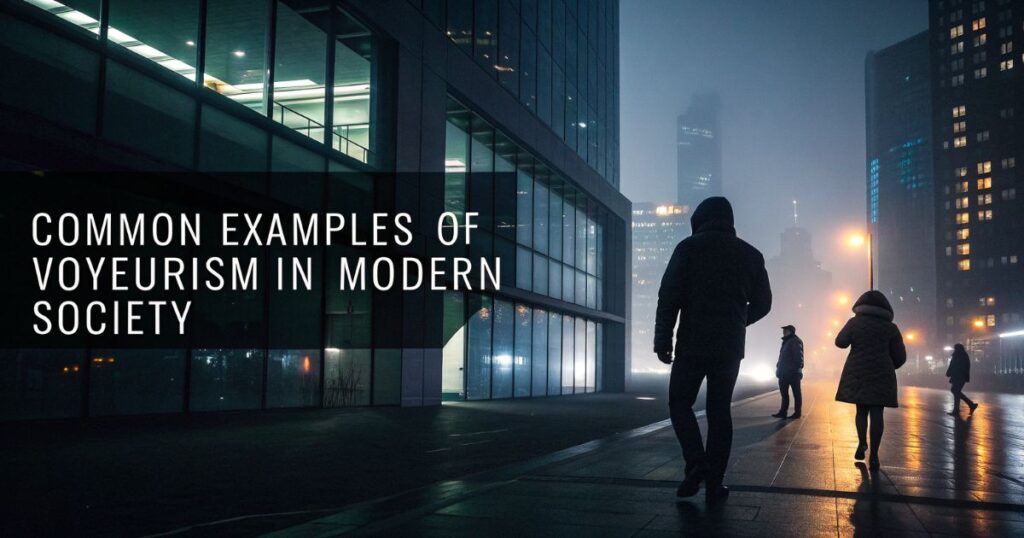Voyeurism represents one of society’s most misunderstood behavioral patterns, affecting millions through both traditional and digital means.
You encounter references to voyeuristic behavior daily, whether through news stories, legal cases, or personal experiences.
Understanding this term helps you navigate modern privacy challenges and protect yourself from potential violations.
What Does Voyeurism Actually Mean in Plain English?
Voyeurism derives from the French word “voyeur,” meaning “one who sees.” The term describes the practice of gaining sexual arousal or psychological satisfaction from secretly observing others without their knowledge or consent.
Clinical psychology defines voyeurism as a paraphilic disorder when it becomes compulsive or causes distress. However, the everyday usage extends beyond clinical definitions to include various forms of unauthorized observation.
The key elements distinguishing voyeurism include secrecy, lack of consent, and personal gratification. These three components separate voyeuristic behavior from legitimate observation or surveillance.
Many people mistakenly believe voyeurism only involves sexual motivation. Reality proves more complex, encompassing curiosity-driven observation, power dynamics, and psychological control mechanisms.
Modern technology has dramatically expanded what constitutes voyeuristic behavior. Digital platforms, surveillance equipment, and social media create new opportunities for unauthorized observation.
Legal Implications of Voyeurism in the United States
Federal legislation addresses voyeurism through the Video Voyeurism Prevention Act of 2004, criminalizing unauthorized recording in private settings. Penalties include fines up to $100,000 and imprisonment for one year.
State laws vary considerably in scope and severity. California’s Penal Code 647(j) imposes misdemeanor charges for first offenses, while Texas classifies voyeurism as a state jail felony with potential two-year sentences.
Technology-related voyeurism faces additional federal oversight through computer fraud and cyberstalking statutes. The Violence Against Women Act provides enhanced penalties when victims experience domestic violence connections.
Court precedents establish that reasonable expectation of privacy determines legal violations. Bathrooms, bedrooms, and private residences receive strongest protection, while public spaces offer limited privacy expectations.
Enforcement challenges multiply with advancing technology. Law enforcement agencies report 340% increases in digital voyeurism cases between 2020-2024, straining investigative resources and legal frameworks.
Civil liability accompanies criminal charges in most jurisdictions. Victims can pursue damages for emotional distress, invasion of privacy, and intentional infliction of emotional harm through separate civil proceedings.
Common Examples of Voyeurism in Modern Society

Digital stalking represents the most prevalent modern form. Perpetrators use social media platforms, location tracking, and online surveillance to monitor targets’ activities without consent or knowledge.
Workplace voyeurism manifests through unauthorized recording, excessive monitoring beyond job requirements, and invasion of employee privacy in restrooms or changing areas.
Revenge voyeurism involves sharing private images or videos without consent, often following relationship breakdowns. The Cyber Civil Rights Initiative documents over 10,000 annual cases nationwide.
Paparazzi activities blur legal boundaries when targeting celebrities in private settings. Long-range photography, property trespassing, and harassment tactics often constitute voyeuristic behavior under legal definitions.
Hidden camera installations in rental properties, hotels, and public facilities create widespread privacy violations. Security experts estimate over 50,000 unauthorized recording devices operate in commercial establishments annually.
Online voyeurism through hacked webcams, stolen cloud storage, and unauthorized access to private accounts affects millions of internet users. Cybersecurity firms report 25% increases in privacy-related breaches yearly.
Voyeurism vs Privacy Invasion: Understanding the Differences
Intent distinguishes voyeurism from general privacy invasion. Voyeuristic behavior seeks personal gratification, while privacy invasion may involve commercial, investigative, or security purposes without gratification elements.
Legal frameworks treat these violations differently. Privacy invasion often results in civil penalties and regulatory fines, whereas voyeurism carries criminal charges with potential imprisonment.
Consent factors play crucial roles in legal determinations. Some privacy invasions occur with limited consent through terms of service agreements, while voyeurism definitionally excludes meaningful consent.
Remedial approaches vary significantly between violation types. Privacy invasion victims typically pursue civil remedies and regulatory complaints, while voyeurism victims access both criminal prosecution and civil damages.
Corporate surveillance versus individual voyeurism receives different legal treatment. Companies face regulatory oversight and civil penalties, while individual voyeurs encounter criminal prosecution and societal stigma.
Evidence requirements differ substantially between privacy invasion and voyeurism cases. Voyeurism prosecution requires demonstrating gratification motives, while privacy invasion focuses on unauthorized access or disclosure.
Technology’s Role in Modern Voyeuristic Activities
Smartphone technology enables unprecedented voyeuristic capabilities. High-resolution cameras, extended battery life, and discrete recording applications facilitate unauthorized documentation in previously impossible scenarios.
Hidden surveillance equipment becomes increasingly sophisticated and accessible. Miniaturized cameras, wireless transmission capabilities, and extended storage options create persistent monitoring threats.
Social media platforms inadvertently facilitate voyeuristic behavior through location sharing, photo tagging, and activity tracking features. Privacy advocates estimate 78% of users unknowingly share exploitable personal information.
Cloud storage vulnerabilities expose private content to unauthorized access. Major data breaches in 2023-2024 compromised over 2.3 million personal accounts containing intimate materials.
Artificial intelligence amplifies voyeuristic capabilities through facial recognition, behavior prediction, and automated monitoring systems. Machine learning algorithms can identify patterns and predict activities from limited data.
Internet of Things devices create new surveillance vectors through smart home technology, wearable devices, and connected appliances that collect detailed behavioral data without explicit user awareness.
Recognizing Voyeuristic Behavior Warning Signs
Excessive curiosity about private activities, persistent questions about personal routines, and unusual interest in private spaces indicate potential voyeuristic tendencies requiring attention.
Technology manipulation including unexplained device access, suspicious app installations, or unusual network activity may signal unauthorized monitoring attempts by voyeuristic individuals.
Behavioral changes in observed individuals often reveal voyeuristic activity. Increased anxiety, privacy concerns, or reports of feeling watched warrant investigation into potential unauthorized observation.
Physical evidence such as unfamiliar devices, repositioned objects, or technical equipment in private areas suggests possible surveillance installation by voyeuristic perpetrators.
Digital footprints including unauthorized social media activity, mysterious photo appearances, or unexplained online account access indicate potential digital voyeurism targeting.
Professional intervention becomes necessary when voyeuristic behaviors escalate, cause distress, or violate legal boundaries. Mental health professionals and law enforcement provide appropriate response resources.
Cultural Impact and Media Representation of Voyeurism
Entertainment media often glamorizes voyeuristic behavior, presenting unauthorized observation as romantic or adventurous rather than invasive and harmful to victims’ wellbeing and privacy.
Reality television blurs consent boundaries by encouraging exhibitionist behavior while maintaining voyeuristic audience appeal. Media critics argue these formats normalize privacy violations through entertainment consumption.
Social media culture creates paradoxical relationships with privacy and observation. Users simultaneously seek attention while maintaining privacy expectations, complicating voyeurism discussions and legal frameworks.
Celebrity culture perpetuates voyeuristic consumption through paparazzi imagery, unauthorized recordings, and invasive media coverage that society accepts as entertainment rather than privacy violation.
Generational differences affect voyeurism perception and acceptance. Younger demographics raised with social media show different privacy expectations compared to older generations with traditional privacy concepts.
Cultural movements increasingly challenge voyeuristic normalization through consent education, privacy advocacy, and legal reform efforts targeting unauthorized observation and exploitation behaviors.
FAQ Section
Is voyeurism always illegal, or are there legal gray areas?
Voyeurism laws vary by location, consent, and situation.
Private spaces with privacy expectations are strongly protected.
Public watching may be legal but recording or stalking makes it criminal.
What’s the difference between voyeurism and simply being curious about others?
Curiosity respects boundaries and relies on consent.
Voyeurism breaks boundaries and involves secret access.
The key difference is consent and respecting privacy expectations.
How can someone protect themselves from becoming a victim of voyeuristic behavior?
Update devices, limit social media sharing, and watch location settings.
Check private spaces for hidden devices and trust instincts.
Use legal protections like restraining orders or prosecution if targeted.
Conclusion
Voyeurism affects countless individuals through both traditional observation and modern digital surveillance methods that violate personal boundaries.
You now understand the legal, psychological, and cultural dimensions that shape voyeuristic behavior in contemporary society. Protecting yourself and respecting others’ privacy creates safer communities while upholding fundamental human dignity and personal autonomy.
More Posts
What Does It Symbolize When a Ladybug Lands on You
Growler Meaning: Breaking Down the Term and Reviewing Respectful Alternatives
LWK Meaning — Hiatus Explanation of LWK Meaning, How It’s Used, and Substitutes

Welcome to Brightnis! I am the admin and creator of this platform. I love questioning ideas and exploring different situations. My goal is to encourage critical thinking and help people see things from new perspectives. Join me in discussing thought-provoking topics and finding unique solutions to everyday challenges!






